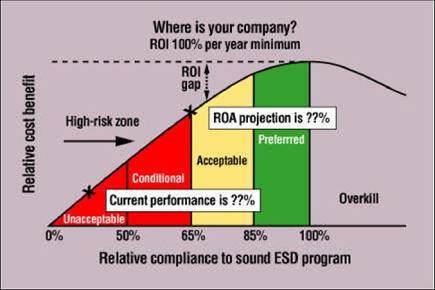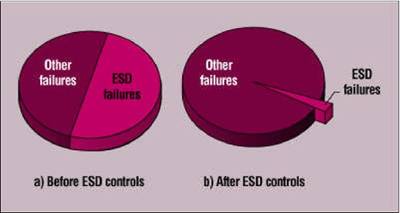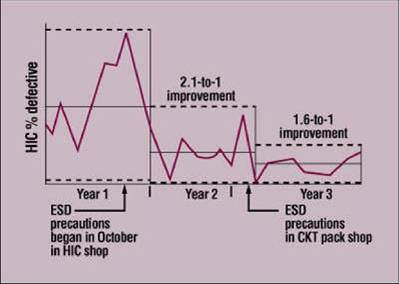“During the several months of the contract, I felt incredibly grateful for what you did for Finisar, and much more deeply realized just how unique the service you provide is!”.–Bob Herrick, Ph.D.
3 ESD Class 0 Success Stories | ESD Myths, Latency & Success Stories | EOS Misdiagnosis & Success Story | Economic Benefits | Testimonials
Strategic and Economic Benefits of an ESD Program
Ted Dangelmayer
An effective ESD program is essential to maintaining quality and reliability, but it also provides both strategic and economic benefits to electronics manufacturers.
Looking to the future, the need for state-of-the-art ESD design and manufacturing practices will only intensify. This is because the rapid advance of technology and the associated design constraints are producing devices with ever- increasing sensitivity to ESD. A recent Sematech benchmarking study of integrated circuit (IC) suppliers indicated that ESD will be one of the top three reliability concerns within the next five years, and already is a major concern with certain products.
Developing, implementing, and managing a successful electrostatic discharge (ESD) program to offset this trend requires a total system approach that extends from product design to customer acceptance. Industry standards such as ANSI/ESDA S20.20 are helping companies converge on one set of handling practices.1 The program will, however, still need to be well managed and woven into every aspect of the development and manufacturing processes in order to produce lasting success. In fact, a well-managed program can be far more effective than one well stocked with expensive supplies. Twelve critical factors (see Table I) form the basis of successful ESD program management.2
Factor One |
An effective implementation plan |
Factor Two |
Management commitment |
Factor Three |
A long-term process owner |
Factor Four |
An active leadership team |
Factor Five |
Realistic requirements |
Factor Six |
Training for measurable goals |
Factor Seven |
Auditing using scientific measures |
Factor Eight |
ESD test facilities |
Factor Nine |
A communication program |
Factor Ten |
Systematic planning |
Factor Eleven |
Human factors engineering |
Factor Twelve |
Continuous improvement |
Table I. The 12 critical factors for successful ESD program management.
Manufacturing Improvement |
Result |
Removed gloves |
Savings of $30,000/year |
Reduced packaging |
Savings of $786,000/year |
Identified production problems (e.g., EMI events at surface mount, RF shield highly charged, black carrier and clear cover tape at 15,000 V) |
50% yield improvement |
Identified production problems at EMS site (benches not grounded) |
Changed to a tier 1 EMS supplier; added frequencyaud its by a major ESD supplier |
Table II. Examples of manufacturing improvements and cost savings.
The strategic and economic benefits of an ESD program far outweigh the associated implementation expenses. A way to measure these benefits has been elusive for many companies. On the other hand, Dangelmayer Associates has had considerable success in proving that a well-managed ESD program introduces dramatic strategic and economic benefits. Measurable financial indicators alone justify program expenses. However, after considering the intangible strategic benefits, the value of a sound ESD program becomes overwhelming and can range from $100 million to $500 million per year, per site in larger companies.

Figure 1 illustrates one measure of the effectiveness of sound program management with the results of a nine-month study. This study was conducted at a Lucent Technologies manufacturing location in which deviations from procedures were carefully tracked using prescribed auditing procedures. The results of this auditing were then compared with the relative removal rates of device failures attributable to ESD, as determined by failure mode analysis. Clearly there is a strong correlation between removal rates and deviations from specified handling procedures (see Table II).

The strategic and economic benefits presented in this article are summarized in four categories: implementation cost avoidance, quality improvements, reliability improvements, and strategic benefits. Figure 2 abstractly represents the combined business impact. A corresponding return on investment develops, typically up to 1000%, as compliance with sound ESD design and manufacturing practices improves. The current performance percentage point of companies can be accurately determined, as well as the return-on-current-assets (ROA) percentage point projection in Figure 2. These data can also be used to generate invaluable benchmarking data, as shown in Figure 3.
A full understanding of ESD technology and manufacturing techniques enables the ESD process owner and design engineer to know where to draw the line between necessary insurance and costly overkill. Programs operating in the high-risk zone run a serious risk of catastrophic production stoppage, severe reliability failures, and lost sales revenue. Major quality and reliability busts have been known to cost up to $10 million dollars each and jeopardize millions of dollars in sales.
An optimum level of protection at the lowest possible cost can be achieved by following proven techniques previously published.2 Such protection resulted in the realization of the following strategic and economic benefits for Lucent Technologies.
Implementation Cost Avoidance
Economic gains are maximized when implementation costs are controlled and unnecessary costs are avoided. This is accomplished by selecting realistic solutions based on sound technology and placing a very high priority on a well-managed program.
For instance, even though auditing is a vitally important part of managing an effective program, it could be rather costly. However, using basic statistical-sampling techniques, 8000 people can be audited by one person. Savings both in labor and in reduced ESD losses are significant and can be attributed to the improved compliance with specified procedures. Used properly, auditing results also make it possible to leverage limited resources effectively. For example, the auditing data can identify those employees having the greatest need for additional training.
The selection of control materials has a major effect on implementation costs. For instance, during a factory modernization program, Lucent substituted a conductive floor finish for the installation of conductive floor tile and avoided a $5-million expense in the process. The floor tile had been planned for approximately a million square feet; by substituting the finish, Lucent realized an average cost avoidance of $5 per square foot.
Today ESD carpet is often used to avoid the high maintenance cost of ESD finishes. The company also found through research and experience that dissipative materials provide ample protection in most cases and that the more expensive shielding materials are generally unnecessary. The use of best-value products can also result in substantial savings and enhanced quality.
Other areas where sums of money can be saved include the omission or limited use of items such as smocks, ionizers, constant monitors, conductive chairs, and high-maintenance floors. For instance, one customer site eliminated ESD gloves costing $30,000 per year, and at another, packaging costs were reduced by $786,000 per year.
Quality Improvements
Before instituting ESD controls, Lucent Technologies' manufacturing suffered losses estimated to be in excess of $325 million per year. The estimate was based on the experience of a number of locations, and on the results of a battery of carefully controlled experiments conducted on the manufacturing floor.
Defect levels were known to vary dramatically from one product line to another. In some instances, virtually every device failed at an annualized cost of $10 million. In others, 2% dropouts were recorded. However, all of the product lines, even the more robust ones, experienced losses that justified using ESD control measures.
ESD defect levels were found to be 50% of the electrical failures (see Figure 4a). Failure analysis confirmed ESD as the cause of these failures. After implementing ESD controls, Lucent experienced corresponding yield improvements. In fact, the dramatic improvements greatly enhanced productivity and produced additional test-set capacity.

After implementing systematic controls, the dramatic quality improvements that had been predicted experimentally became a reality. Locations such as the Denver Works reported savings of $5 million in the first year, with a rate of return on investment of 3000%. Since then, the cumulative cost avoidance in Denver has totaled $114 million. The Reading Works experienced a 15% overall yield improvement, and Merrimack Valley realized $9 million in savings per year with a rate of return of 1000%. These savings do not include overhead and therefore reflect true cost improvements.
Currently, ESD losses at Lucent Technologies are minimal. In fact, a review of failures detected by quality assurance (see Figure 4b) revealed that only three out of three million devices tested failed due to ESD, or one in a million.
The three devices that did fail were analyzed in great detail, and assignable causes were determined. In all three instances, the failures were process related, and none were the result of human error. In one instance, the failure was traced to a charged cable assembly used during the quality assurance test procedure. The other two were damaged by the nylon brushes in a mass-soldering machine used to clean the printed wiring board (PWB) assemblies after soldering.
Similar success has been noted at other locations. For instance, the Denver Works reported that only 0.23% of the production failures returned for analysis were ESD induced. The Allentown Works did an analysis of all failures detected during a reliability monitoring operation and found ESD to be the cause of only 1% of the defects.
Reliability Improvements
The reliability benefits associated with ESD control are significant and are among the primary concerns of customers. Reliability failures can result from either latency or from cumulative damage. In one instance, reliability failures amounted to $150,000 per week until a design change was implemented to correct the problem.

(percent defective HICs versus time).
The company found a 3-to-1 improvement in the reliability of outgoing PWB assemblies over a two-year period (see Figure 5). This was determined by analyzing quality assurance results of a system reliability test conducted on outgoing PWB assemblies. Detailed records made it possible to determine that the improvement resulted from the introduction of ESD control measures in the manufacturing process prior to these tests. Similar results were obtained during a controlled experiment that produced a 5-to-1 improvement. During the same time frame, there was a 25% reduction in field returns.
Strategic Benefits
The financial indicators are impressive, but they do not even begin to compare to the strategic benefits provided by a sound ESD control program. These intangibles stem primarily from customer satisfaction and the resulting improvement in sales and customer relations.
To protect their investment, informed customers place stringent handling and design requirements on vendors. They are aware of the quality and reliability implications. Furthermore, the handling procedures are a visible sign of a company's commitment to quality. It is, therefore, doubly important to meet or exceed the ESD requirements in the interest of customer satisfaction and improved quality.
However, ESD program requirements vary widely among customers, and it is not cost effective to implement multiple ESD programs to satisfy these varying requirements. Most customers will, however, accept a sound, total-system approach. Consequently, an industry-recognized program that incorporates a total-system approach has significant strategic and economic benefits. For similar reasons, the incorporation of an industry standard such as ANSI/ESDA S20.20 is also strongly recommended.
During visits to the factory, customers often comment on the consistent use of wrist straps and conductive footwear. It has a very positive effect on their perception of product offerings, and for good reason. Consequently, encourage these observations by challenging visitors to see whether they can find an employee who is not properly grounded. This often leads to customers questioning their own ESD control program and requesting assistance with certain procedures.
This interaction can improve customer relations, especially if the customer's company is a recognized authority in that industry. For ESD control techniques, it is possible to work with customers from the usual perspective of end-users on problems in common. In this regard, the experience gained in a manufacturing environment is an invaluable resource because of the unbiased quantitative information readily available. This experience makes it possible to help customers develop their own program and realize the same economic gains while minimizing control costs.
These discussions and interactions are mutually beneficial for customers and suppliers. Customers gain valuable experience in cost-effective controls, improve their service position, and reduce the number of board failures and associated costs. Suppliers experience an improvement in warranty costs due to fewer field returns. The result is improved customer relations and, ultimately, increased sales.
Improvement in sales can also be realized by differentiating product offerings based on ESD handling controls and designed-in protection. In fact, at Lucent Technologies both of these issues are formally reviewed during customer audits of the manufacturing process and are part of the supplier evaluation. A negative report in this area has been known to result in lost contracts. A positive review, however, has been known to contribute to the differentiation necessary to secure substantial contracts. For instance, an executive representing a major customer made the following statement: "Whoever comes up with the most robust ESD design will have a competitive edge in selling their products!" On a separate occasion an executive said, "The consistent use of wrist straps was impressive, and it is evident that you have a strong commitment to quality. This will have a bearing on our product selection."
References
- ANSI/ESDA S20.20, "Protection of Electrical and Electronic Parts, Assemblies and Equipment," (ESD Association), available from Internet:http://www.esda.org
- Ted Dangelmayer, ESD Program Management, 2nd ed. (Norwell, MA: Kluwer Academic Publishers, 1999).
Ted Dangelmayer is president of Dangelmayer Associates LLC (http://www.dangelmayer.com).

